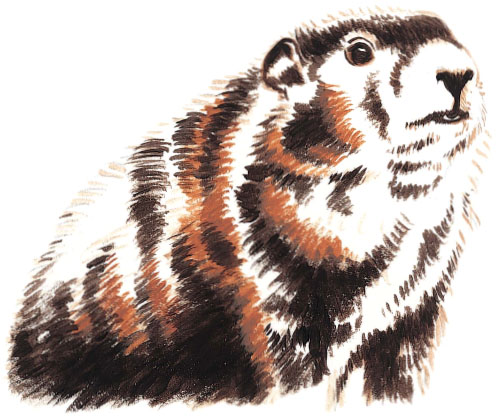Project 37: Woodchuck
Woodchucks, also known as groundhogs, are large rodents that belong to the marmot group. They are excellent diggers and hibernate in the winter by burrowing underground. Woodchucks have small ears, a frosted brown coat, dark feet, long claws on the front feet and lighter coloring around the nose.

Materials
Paints
Burnt Sienna
Burnt Umber
Raw Sienna
Titanium White
Ultramarine Blue
Yellow Oxide
Brushes
no. 0, 1 and 3 rounds
no. 2 filbert

1 Establish the Form
Sketch the woodchuck lightly in pencil. Paint the main lines and form with a no. 3 round and Burnt Umber thinned with water. (From now on, paint with a small to moderate amount of water on your brush, unless otherwise indicated.)

2 Paint the Darkest Values and Begin the Middle Values
Mix the dark brown for the darkest parts of the coat with Burnt Umber and a moderate amount of Ultramarine Blue. Paint with a no. 3 round. Paint the nose, mouth, inside the ear and the shadowed areas of fur, following the direction the fur grows. Paint the eye with a no. 1 round. Mix the brownish middle value color with Titanium White, Raw Sienna and Burnt Sienna. Begin to paint this color with a no. 2 filbert.

3 Paint the Middle Values and Begin the Highlights
Continue painting the middle value with the no. 2 filbert, switching to a no. 3 round for the smaller areas around the eye, nose and mouth. Leave the lightest, highlighted parts of the coat white. As the paint dries, add more layers of paint until the surface is well covered. Then use a no. 3 round to begin stroking some of the dark brown you mixed in Step 2 from the dark areas out into the middle value areas. Use the same brush and dark brown color to start adding smaller areas of dark fur over the brownish middle value color.
Mix the bluish color for inside the ear, the top of the nose and the brow line with Titanium White, Ultramarine Blue and Burnt Umber. Paint with a no. 1 round, then use a separate no. 1 round and the dark brown color to stroke the edges, integrating the two colors. Mix the highlight color with Titanium White and a small amount of Yellow Oxide. Begin to paint highlights along the chest, head and front leg with a no. 1 round.

WOODCHUCK
Acrylic on illustration board
8” × 10” (20cm × 25cm)
4 Paint the Details
Continue to paint dark brown fur detail with a no. 1 round. Woodchucks have a brown coat that is sprinkled with light-colored hairs. Paint these hairs over the brown so that the brown coat underneath shows through between the brushstrokes. With a no. 1 round, paint the highlight color you mixed in Step 3 along the woodchuck’s back, fading gradually into the body. In the broad areas of dark brown, use a no. 1 round to paint hair detail with the brownish middle value you mixed in Step 2. Then, with a separate no. 1 round, paint some of the highlight-colored hairs that are sprinkled over the coat. If they appear too bright, use the no. 1 round with some of the brownish middle value color thinned with water to glaze over them.
Paint the eye highlight with a no. 1 round using a mixture of Titanium White and a touch of Ultramarine Blue. Make a small, curving brushstroke to show the roundness of the eyeball. Paint the whiskers overlapping the body (on the right side) with the dark brown color mixture from Step 2 and a no. 0 round. Paint the whiskers overlapping your background with the highlight color and a separate no. 0 round, using enough water so the paint flows easily. Make corrections as needed by painting over a whisker with your surrounding color, then repainting.
